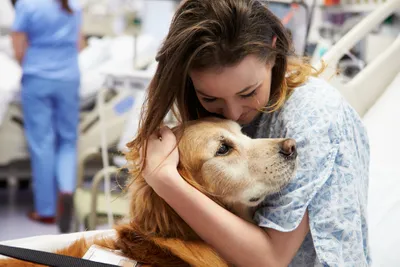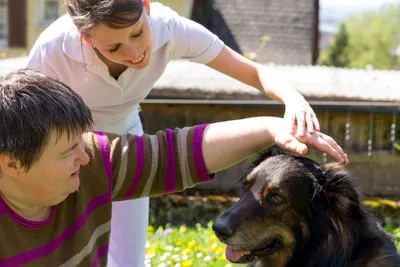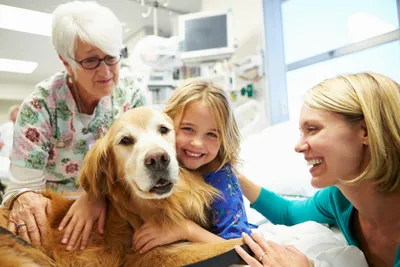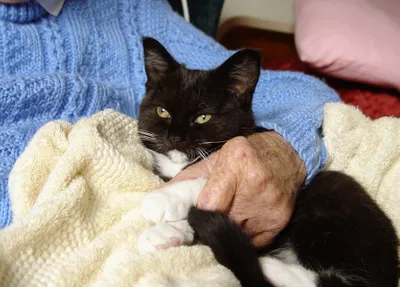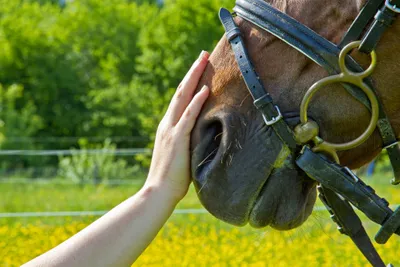The magical bond between humans and animals has existed for millennia. Animals have played an integral part in our history as a source of food, clothing and survival. Some evolved into sources of protection, companionship and elevated in status to that of family or friend. Communication between humans and animals occurs on a deeper, more primitive level than the spoken word. Animals force us to become self-aware in regards to things such as our tone, body language and the 95-percent of communication which is non-verbal.
Therapy through animals can assist in emotional and physical healing. Pet therapy is a structured and goal oriented interaction between people and specially trained animals. According to the American Veterinary Association (2013), pet therapy can help improve human physical, emotional, social and cognitive function. Let’s take a closer look…
1. Who Benefits from Pet Therapy?
Pet therapy can be useful in treating patients with depression, anxiety, panic disorder or social phobias. Veterans with Post Traumatic Stress Disorder can benefit from this type of therapy. Patients hospitalized with cancer, heart failure, chronic illness, strokes or brain injuries have been helped with pet therapy.
In addition long term care residents, children requiring physical or dental procedures, victims of abuse and domestic violence, and even convicts have made significant progress in their mental and physical health when pet therapy was initiated.
2. Steps to Pet Therapy
The health care provider in charge of managing the patient’s treatment is usually the one to initiate pet therapy. A trained handler will take the pet to each session or in the case of equine therapy, will be present to assist when the patient arrives.
They work towards achieving goals which have been pre-determined in advance by the provider, handler and patient. You can rest assured that each animal, no matter the breed or species must pass a rigorous screening and training process prior to making its debut as a pet therapy animal.
3. Physical Benefits of Pet Therapy
Studies have shown that therapeutic contact with animals lowers blood pressure and reduces heart rate. Playing with pets can stimulate both adults and children to become more physically active. For example, when disabled patients throw a ball to a dog, they are using eye-hand coordination as well as strengthening their reflexes and arm muscles.
Children with muscle weakness have benefited from the assistance of a dog to support them in their efforts to stand and walk. Research has found that pet owners have decreased levels of triglycerides and cholesterol which are factors that can protect heart health.
4. Emotional Benefits
Researchers have discovered that people who are engaged in positive interactions with animals have higher levels of the “feel good” chemicals dopamine and serotonin. These substances help regulate mood, combat depression, reduce anxiety and allow us to remain calm in stressful situations. Victims of domestic violence and abuse can benefit from the non-judgmental companionship of an animal.
Pet therapy helps a survivor feel “safe”, valued and able to freely express their emotions. Interacting with animals can stimulate laughter and joy in people whose lives have been overwhelmed by illness or depression.
5. Social Benefits
Pet therapy can bring people out of their shell. Animals provide a safe avenue for people to explore the basic human need for touch. Petting a dog, cat, small animal or horse can be both comforting and calming. Animals are non-judgmental and affectionate.
For people with social phobias, autism, or mental illness, relating to a pet can be the first step to forming new and healthy relationships with others. Animals can also inspire laughter and joy which in turn can help them connect to their health care provider, therapist, family and peers.
6. Cognitive Benefits
Pet therapy helps reduce stress and anxiety which in turn has a positive effect on a person’s decision making abilities. This allows one to make a calm, carefully measured and rational decision instead of panicking and reacting to stressful events. Another way in which animals improve our cognition is that they improve our self-awareness.
They react instantly to our moods and give immediate feedback. If we hit a dog or a horse we may get bitten or kicked. For this reason pet therapy has been especially useful for convicts. They must learn to connect with an animal using an approach other than intimidation and violence. Once they achieve this they will be rewarded with the animal’s trust and loyalty.
7. Visiting Animals
Dogs are the animals most frequently used as visiting pet therapists to attend hospitals, nursing homes, and cancer wards. There are three types of therapy dogs. The first is called a Therapeutic Visitation Animal. These dogs are most often family pets whose owner wants to share the joy of their companionship with others.
The second types are Animal Assisted Therapy Animals. These dogs are specially trained to help support patients with physical rehabilitation by improving their fine motor skills, range of motion, balance and interactive skills. The third types are called Facility Therapy Animals. These animals live in the facility in which they work, such as long term care and group homes.
8. Service Animals
Service animals are specially trained to provide a service to their disabled handler as opposed to a therapy animal who is trained to provide a service to others who may not have a disability at all. Public access rights are unique to service animals and are not shared by therapy pets. Service animals include seeing-eye dogs for the blind or deaf and search and rescue dogs.
Mini horses have also been used as service animals for the handicapped. These animals are chosen at a young age according to stringent criteria and go through a rigorous training program. They provide an invaluable service to their handicapped handlers.
9. Cats and Small Companion Animals
Cats and small animals such as hamsters or rabbits are small, easy to care for animals that are often Facility Therapy Animals who live in the same residence as the patients they provide therapy for. Nursing homes, long term care facilities, daycare and group homes are some of the institutions in which these animals can be found. Problems can arise if a patient is allergic to them or if residents are not properly monitored when interacting with pets.
Residents who are cognitively impaired or who are not fond of these pets may be rough or abusive to the animal. In addition, staff need to be vigilant to make sure medications are not spilled or left on the floor as animals have been known to accidentally ingest them and suffer adverse health consequences as a result.
10. Riding a Horse
As early as 600 B.C, the Ancient Greeks realized the therapeutic value of horseback riding. Horses can augment emotional, social and physical rehabilitation. Riding a horse provides passive, isometric exercise which promotes muscle strengthening in disabled individuals. For patients who are paralysed or unable to walk, horseback riding provides them with a wonderful, new means of mobility.
Wild Mustangs have been used in Colorado to rehabilitate convicts. These hardened criminals are assigned a wild horse who they train and are then offered for adoption. They must develop new social skills including compassion, self-awareness and heightened communication. Equine therapy has also been used to assist veterans with PTSD. The veteran must build a bond of respect and understanding with a discarded race horse until the horse concedes and “joins up” with them. Only then can the horse be successfully be retrained for a new career. This emotional binding between horse and man has brought more than one veteran to tears.

